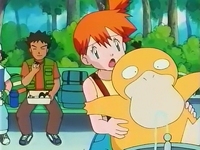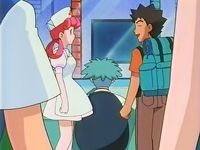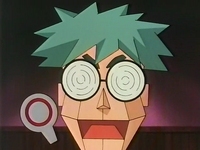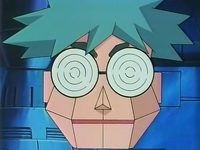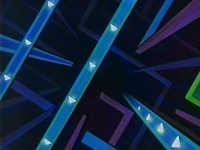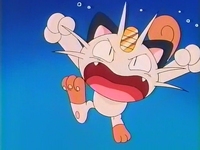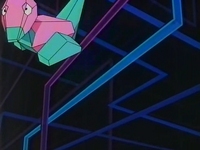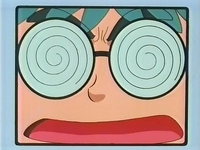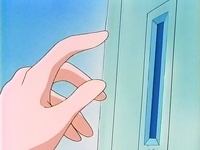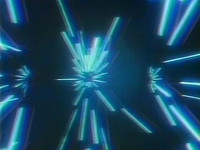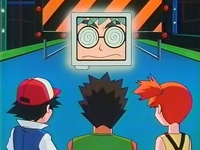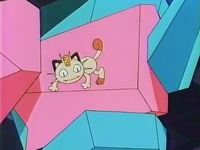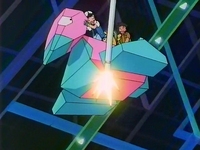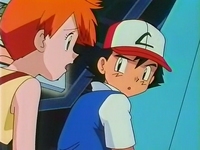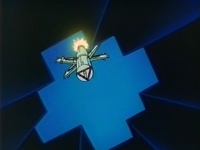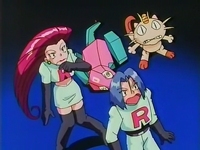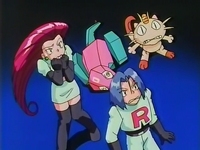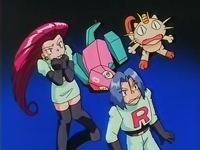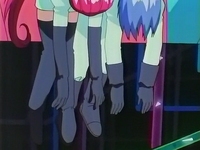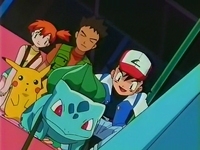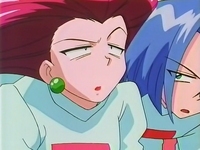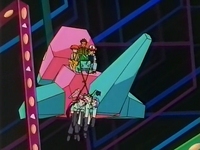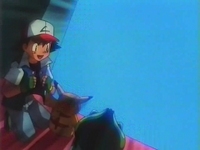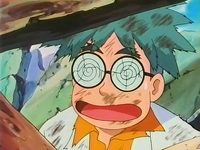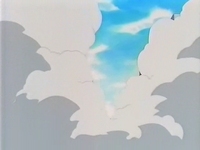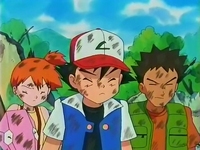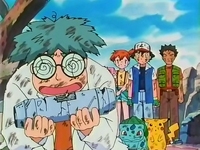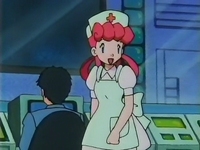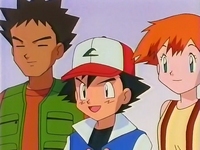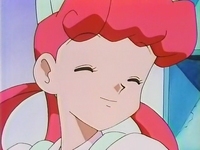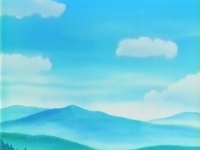Media

Titles and Airdates
Staff List
| Screenplay | 武上純希 (Junki Takegami) | |
| Storyboard | 井硲清高 (Kiyotaka Itani) | |
| Episode Director | 井硲清高 (Kiyotaka Itani) | |
| Animation Director | 志村隆行 (Takayuki Shimura) |
OP/ED List

Aim To Be A Pokémon Master

Fantasy in My Pocket
Japanese:
| 三間雅文 (Masafumi Mima) |

|
Voice Director |
| Recording Studio アオイスタジオ (Aoi Studio)  |
Screenplay
脚本
脚本
Storyboard
絵コンテ
絵コンテ
Episode Director
演出
演出
Animation Director
作画監督
作画監督
 志村隆行 (Takayuki Shimura)
(Dragon Production)
志村隆行 (Takayuki Shimura)
(Dragon Production)
Key Animation
原画
原画
 長岡みどり (Midori Nagaoka)
(Dragon Production)
長岡みどり (Midori Nagaoka)
(Dragon Production)
 中村亜貴子 (Akiko Nakamura)
(Dragon Production)
中村亜貴子 (Akiko Nakamura)
(Dragon Production)
 山本謙二 (Kenji Yamamoto)
(Dragon Production)
山本謙二 (Kenji Yamamoto)
(Dragon Production)
 竹渕正美 (Masami Takebuchi)
(Dragon Production)
竹渕正美 (Masami Takebuchi)
(Dragon Production)
 武井智子 (Tomoko Takei)
(Dragon Production)
武井智子 (Tomoko Takei)
(Dragon Production)
 宮川かおり (Kaori Miyagawa)
(Dragon Production)
宮川かおり (Kaori Miyagawa)
(Dragon Production)
 日野寧子 (Yasuko Hino)
(Dragon Production)
日野寧子 (Yasuko Hino)
(Dragon Production)
In-Between Animation Check
動画チェック
動画チェック
In-Between Animation
動画
動画
 小原智恵子 (Chieko Ohara)
(Dragon Production)
小原智恵子 (Chieko Ohara)
(Dragon Production)
 藤村美子 (Yoshiko Fujimura)
(Dragon Production)
藤村美子 (Yoshiko Fujimura)
(Dragon Production)
 鈴木宮生 (Miyao Suzuki)
(Dragon Production)
鈴木宮生 (Miyao Suzuki)
(Dragon Production)
 スタジオダブ (Studio Dub)
スタジオダブ (Studio Dub)
 エムアイ (MI)
エムアイ (MI)
 スタジオムサシ (Studio Musashi)
スタジオムサシ (Studio Musashi)
Color Coordination
色指定
色指定
Inspection
検査
検査
Special Effects
特殊効果
特殊効果
Finishing
仕上げ
仕上げ
Backgrounds
背景
背景
 スタジオじゃっく (Studio Jack)
スタジオじゃっく (Studio Jack)
 宮内早苗 (Sanae Miyauchi)
(Studio Jack)
宮内早苗 (Sanae Miyauchi)
(Studio Jack)
 高橋和博 (Kazuhiro Takahashi)
(Studio Jack)
高橋和博 (Kazuhiro Takahashi)
(Studio Jack)
 高尾克己 (Katsumi Takao)
(Studio Jack)
高尾克己 (Katsumi Takao)
(Studio Jack)
 日比野晶子 (Akiko Hibino)
(Studio Jack)
日比野晶子 (Akiko Hibino)
(Studio Jack)
Title・Lithography
タイトル・リスワーク
タイトル・リスワーク
Photography
撮影
撮影
 スタジオコスモス (Studio Cosmos)
スタジオコスモス (Studio Cosmos)
 前原勝則 (Katsunori Maehara)
(Studio Cosmos)
前原勝則 (Katsunori Maehara)
(Studio Cosmos)
 大藤哲生 (Tetsuo Ōfuji)
(Studio Cosmos)
大藤哲生 (Tetsuo Ōfuji)
(Studio Cosmos)
 黒田洋一 (Yōichi Kuroda)
(Studio Cosmos)
黒田洋一 (Yōichi Kuroda)
(Studio Cosmos)
 野口博志 (Hiroshi Noguchi)
(Studio Cosmos)
野口博志 (Hiroshi Noguchi)
(Studio Cosmos)
 池上伸治 (Shinji Ikegami)
(Studio Cosmos)
池上伸治 (Shinji Ikegami)
(Studio Cosmos)
 蓜島尚久 (Naohisa Haijima)
(Studio Cosmos)
蓜島尚久 (Naohisa Haijima)
(Studio Cosmos)
Video Editing
ビデオ編集
ビデオ編集
Production Assistant
制作進行
制作進行
Animation Production
アニメーション制作
アニメーション制作
Music
音楽
音楽
Recording Studio
録音スタジオ
録音スタジオ
Summary
Characters

 Ash Ketchum
Ash Ketchum サトシ
サトシ Satoshi
Satoshi Satoshi
Satoshi

 Ash's Pikachu
Ash's Pikachu サトシのピカチュウ
サトシのピカチュウ Satoshi no Pikachu
Satoshi no Pikachu Satoshi's Pikachu
Satoshi's Pikachu

 Misty
Misty カスミ
カスミ Kasumi
Kasumi Kasumi
Kasumi

 Brock
Brock タケシ
タケシ Takeshi
Takeshi Takeshi
Takeshi

 Meowth
Meowth ニャース
ニャース Nyarth
Nyarth Nyarth
Nyarth

 Jessie
Jessie ムサシ
ムサシ Musashi
Musashi Musashi
Musashi

 James
James コジロウ
コジロウ Kojirō
Kojirō Kojiro
Kojiro

 Nurse Joy
Nurse Joy ジョーイ
ジョーイ Joy
Joy Joy
Joy

 Nurse Joy's Chansey
Nurse Joy's Chansey ジョーイのラッキー
ジョーイのラッキー Joy no Lucky
Joy no Lucky Joy's Lucky
Joy's Lucky

 Ash's Bulbasaur
Ash's Bulbasaur サトシのフシギダネ
サトシのフシギダネ Satoshi no Fushigidane
Satoshi no Fushigidane Satoshi's Fushigidane
Satoshi's Fushigidane

 Misty's Psyduck
Misty's Psyduck カスミのコダック
カスミのコダック Kasumi no Koduck
Kasumi no Koduck Kasumi's Koduck
Kasumi's Koduck

 Jessie's Arbok
Jessie's Arbok ムサシのアーボック
ムサシのアーボック Musashi no Arbok
Musashi no Arbok Musashi's Arbok
Musashi's Arbok

 James's Weezing
James's Weezing コジロウのマタドガス
コジロウのマタドガス Kojirō no Matadogas
Kojirō no Matadogas Kojiro's Matadogas
Kojiro's Matadogas

 Professor Akihabara
Professor Akihabara アキハバラ博士
アキハバラ博士 Akihabara-hakase
Akihabara-hakase Professor Akihabara
Professor Akihabara

 Porygon Unit 00
Porygon Unit 00 ポリゴン零号機
ポリゴン零号機 Porygon Zerogōki
Porygon Zerogōki Porygon Unit 00
Porygon Unit 00

 Porygon Unit 01
Porygon Unit 01 ポリゴン初号機
ポリゴン初号機 Porygon Shogōki
Porygon Shogōki Porygon Unit 01
Porygon Unit 01
Wild Pokémon

 Ninetales
Ninetales キュウコン
キュウコン Kyukon
Kyukon

 Magikarp
Magikarp コイキング
コイキング Koiking
Koiking
00:00
Culture Reference
Hulu Japan did not post this episode in their archive. The availability notice stated: "Season 1, Episode 38 is not available in accordance to our company intentions." The preview for episode 38 is included in the Hulu stream of episode 37 though unlike the airings of the episode on stations like Kids Station.


00:00
Culture Reference
The season finale of the Simpsons 10th season was "Thirty Minutes Over Tokyo". The Simpsons family watches a show called "Battling Seizure Robots", a Japanese seizure-inducing television show that the show is spoofed off of the Porygon episode.


00:00
Culture Reference
"Chinpokomon", the 11th episode of South Park's 3rd season is a parody episode of Pokémon. Kenny ends up dying in the episode due to a seizure.

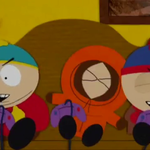


00:00
Culture Reference
TV Cartoon's Flashes Send 700 Japanese Into Seizures
By SHERYL WuDUNN
Published: December 18, 1997
One moment they were happily munching on their dinner and watching their favorite cartoon show on television. The next moment, hundreds of children across the country were shaking and convulsing and being rushed to hospitals.
In a bizarre illustration of the medical effects that television can have on viewers, more than 700 people were taken to hospitals after having been affected by flashing lights on an animated television show broadcast Tuesday night.
Some children vomited blood and others had seizures or lost consciousness. No one died, though, and no one is expected to. Producers of the cartoon, which is highly popular among kindergarten and primary school children, say that they were stumped over how an animation technique that has been used ''hundreds of times'' could cause such a widespread, violent reaction.
''This may be the first case of mass suffering from photo stimulation,'' Toshio Yamauchi, a professor at Saitama Medical School and chairman of an organization called Electronic Screen Game and Seizures. ''We would like to study this thoroughly,'' he said.
Full News article: http://www.nytimes.com/1997/12/18/world/tv-cartoon-s-flashes-send-700-japanese-into-seizures.html?src=pm

By SHERYL WuDUNN
Published: December 18, 1997
One moment they were happily munching on their dinner and watching their favorite cartoon show on television. The next moment, hundreds of children across the country were shaking and convulsing and being rushed to hospitals.
In a bizarre illustration of the medical effects that television can have on viewers, more than 700 people were taken to hospitals after having been affected by flashing lights on an animated television show broadcast Tuesday night.
Some children vomited blood and others had seizures or lost consciousness. No one died, though, and no one is expected to. Producers of the cartoon, which is highly popular among kindergarten and primary school children, say that they were stumped over how an animation technique that has been used ''hundreds of times'' could cause such a widespread, violent reaction.
''This may be the first case of mass suffering from photo stimulation,'' Toshio Yamauchi, a professor at Saitama Medical School and chairman of an organization called Electronic Screen Game and Seizures. ''We would like to study this thoroughly,'' he said.
Full News article: http://www.nytimes.com/1997/12/18/world/tv-cartoon-s-flashes-send-700-japanese-into-seizures.html?src=pm

00:00
Culture Reference
Pocket Monster incident and low luminance visual stimuli: Special reference to deep red flicker stimulation
Takeo Takahashi and Yasuo Tsukahara
Article first published online: 9 OCT 2007 Pediatrics International
Volume 40, Issue 6, pages 631–637, December 1998
On the evening of 16 December 1997 approximately 700 people around the nation (mostly children) were rushed to hospitals and treated for seizure symptoms. The youngsters had been watching the vastly popular TV animated cartoon series Pocket Monsters (Pokemon). We designated those individuals as a main group, who presumably had simultaneous occurrence of visually induced seizures. Follow-up studies revealed that5–10.4% of Pokemon viewers had various minor symptoms not requiring hospital treatment. We designated those as a subgroup. Due to an official report regarding the problematic TV scene as a low luminance, 12 Hz alternating red/blue stimulus, we attempted an accounting of the Pokemon incident, with regard to the main group in particular, on the basis of electroencephalographic activation by use of low luminance 15 Hz deep red flicker stimulation. In order to explain the entire Pokemon incident, including symptoms experienced by individuals of the subgroup, we considered the possibility that some healthy youngsters may have latent photosensitivity and we thought that such a sensitivity might be disclosed by use of low luminance deep red nicker stimulation which is more provocative of photoparoxysmal response than ordinary high luminance stroboscopic intermittent photic stimulation. For prevention of visually induced seizures by TV viewing, we stress that care should be taken to test not only red nicker but also flickering geometric pattern stimuli.
Source: http://onlinelibrary.wiley.com/doi/10.1111/j.1442-200X.1998.tb02006.x/abstract

Takeo Takahashi and Yasuo Tsukahara
Article first published online: 9 OCT 2007 Pediatrics International
Volume 40, Issue 6, pages 631–637, December 1998
On the evening of 16 December 1997 approximately 700 people around the nation (mostly children) were rushed to hospitals and treated for seizure symptoms. The youngsters had been watching the vastly popular TV animated cartoon series Pocket Monsters (Pokemon). We designated those individuals as a main group, who presumably had simultaneous occurrence of visually induced seizures. Follow-up studies revealed that5–10.4% of Pokemon viewers had various minor symptoms not requiring hospital treatment. We designated those as a subgroup. Due to an official report regarding the problematic TV scene as a low luminance, 12 Hz alternating red/blue stimulus, we attempted an accounting of the Pokemon incident, with regard to the main group in particular, on the basis of electroencephalographic activation by use of low luminance 15 Hz deep red flicker stimulation. In order to explain the entire Pokemon incident, including symptoms experienced by individuals of the subgroup, we considered the possibility that some healthy youngsters may have latent photosensitivity and we thought that such a sensitivity might be disclosed by use of low luminance deep red nicker stimulation which is more provocative of photoparoxysmal response than ordinary high luminance stroboscopic intermittent photic stimulation. For prevention of visually induced seizures by TV viewing, we stress that care should be taken to test not only red nicker but also flickering geometric pattern stimuli.
Source: http://onlinelibrary.wiley.com/doi/10.1111/j.1442-200X.1998.tb02006.x/abstract

00:00
Culture Reference
Japanese cartoon triggers seizures in hundreds of children
December 17, 1997
Web posted at: 4:15 a.m. EST (0915 GMT)
TOKYO (CNN) -- The bright flashing lights of a popular TV cartoon became a serious matter Tuesday evening, when they triggered seizures in hundreds of Japanese children.
In a national survey, the Tokyo fire department found that at least 618 children had suffered convulsions, vomiting, irritated eyes, and other symptoms after watching "Pokemon."
Japanese television network NHK reported that 111 people were still hospitalized Wednesday morning.
TV Tokyo spokesman Hiroshi Uramato said that a later broadcast of the show scheduled for 30 other stations nationwide had been canceled, and that an investigation was under way.
Full Article: http://www.cnn.com/WORLD/9712/17/video.seizures.update/index.html

December 17, 1997
Web posted at: 4:15 a.m. EST (0915 GMT)
TOKYO (CNN) -- The bright flashing lights of a popular TV cartoon became a serious matter Tuesday evening, when they triggered seizures in hundreds of Japanese children.
In a national survey, the Tokyo fire department found that at least 618 children had suffered convulsions, vomiting, irritated eyes, and other symptoms after watching "Pokemon."
Japanese television network NHK reported that 111 people were still hospitalized Wednesday morning.
TV Tokyo spokesman Hiroshi Uramato said that a later broadcast of the show scheduled for 30 other stations nationwide had been canceled, and that an investigation was under way.
Full Article: http://www.cnn.com/WORLD/9712/17/video.seizures.update/index.html

00:00
Culture Reference
Pokémon contagion: photosensitive epilepsy or mass psychogenic illness?
Radford B, Bartholomew R.
Center for Inquiry, Amherst, NY, USA.
South Med J. 2001 Feb;94(2):197-204.
Abstract
We studied a reported illness outbreak occurring on December 16, 1997, involving more than 12,000 Japanese children who had various signs and symptoms of illness after watching an episode of a popular animated cartoon, Pokémon. While photosensitive epilepsy was diagnosed in a minuscule fraction of those affected, this explanation cannot account for the breadth and pattern of the events. The characteristic features of the episode are consistent with the diagnosis of epidemic hysteria, triggered by sudden anxiety after dramatic mass media reports describing a relatively small number of genuine photosensitive-epilepsy seizures. The importance of the mass media in precipitating outbreaks of mass psychogenic illness is discussed.
Source: http://www.ncbi.nlm.nih.gov/pubmed/11235034

Radford B, Bartholomew R.
Center for Inquiry, Amherst, NY, USA.
South Med J. 2001 Feb;94(2):197-204.
Abstract
We studied a reported illness outbreak occurring on December 16, 1997, involving more than 12,000 Japanese children who had various signs and symptoms of illness after watching an episode of a popular animated cartoon, Pokémon. While photosensitive epilepsy was diagnosed in a minuscule fraction of those affected, this explanation cannot account for the breadth and pattern of the events. The characteristic features of the episode are consistent with the diagnosis of epidemic hysteria, triggered by sudden anxiety after dramatic mass media reports describing a relatively small number of genuine photosensitive-epilepsy seizures. The importance of the mass media in precipitating outbreaks of mass psychogenic illness is discussed.
Source: http://www.ncbi.nlm.nih.gov/pubmed/11235034

00:00
Culture Reference
A Follow-up Survey on Seizures Induced by Animated Cartoon TV Program “Pocket Monster”
Yoshiko Ishiguro, Hiroyuki Takada, Kazuyoshi Watanabe, Akihisa Okumura, Kosaburo Aso, Tatsuya Ishikawa
Article first published online: 19 MAR 2004
ISSN 0013-9580. OCLC 1568121. PMID 15030500.
Summary: Purpose: To identify the short-term outcome of patients who had seizures while watching an animated cartoon TV program, “Pocket Monster,” on December 16, 1997.
Methods: One and three years after the incident, questionnaires were sent to physicians of each patient about seizure recurrence, EEGs, and medication.
Results: Among 103 patients in whom epileptic seizures occurred during the TV program and information on the outcomes was available, 25 (24%) patients had a history of unprovoked seizures before the incident (Epilepsy Group), and 78 (76%) did not (Non-Epilepsy Group). Twenty-three (22%) patients were reported to have seizures after the incident, and 15 of them had visually induced seizures. Patients of the Epilepsy Group had more seizure recurrence than did those of the Non-Epilepsy Group (56% vs. 9%; p < 0.0001), either for unprovoked (44% vs. 4%; p < 0.0001) or visually induced seizures (28% vs. 9%; p < 0.05). Of nine patients of the Non-Epilepsy Group who had seizures after the incident, only three developed recurrent unprovoked seizures. In the Non-Epilepsy Group, no difference was found in seizure recurrence between patients in whom valproate (VPA) was prescribed immediately after the incident and in those without medication (one of five (20%) vs. seven of 73 (10%); p > 0.05). EEG was performed at least once in 98 patients after the incident. Photoparoxysmal response (PPR) was present in 45 (46%) patients, and spontaneous epileptiform discharges, in 49 (50%). PPR did not have any correlation with recurrence of seizures, neither spontaneous nor visually induced seizures, whereas spontaneous epileptiform discharges showed a good correlation with seizure recurrence (34% vs. 8%; p < 0.01), including visually induced seizures (24% vs. 2%; p < 0.01).
Conclusions: Short-term outcomes showed that 70 (68%) of 103 patients who had a seizure during the incident had no seizures before and during ≤3 years of follow-up.
Full Article: http://onlinelibrary.wiley.com/doi/10.1111/j.0013-9580.2004.18903.x/full


Yoshiko Ishiguro, Hiroyuki Takada, Kazuyoshi Watanabe, Akihisa Okumura, Kosaburo Aso, Tatsuya Ishikawa
Article first published online: 19 MAR 2004
ISSN 0013-9580. OCLC 1568121. PMID 15030500.
Summary: Purpose: To identify the short-term outcome of patients who had seizures while watching an animated cartoon TV program, “Pocket Monster,” on December 16, 1997.
Methods: One and three years after the incident, questionnaires were sent to physicians of each patient about seizure recurrence, EEGs, and medication.
Results: Among 103 patients in whom epileptic seizures occurred during the TV program and information on the outcomes was available, 25 (24%) patients had a history of unprovoked seizures before the incident (Epilepsy Group), and 78 (76%) did not (Non-Epilepsy Group). Twenty-three (22%) patients were reported to have seizures after the incident, and 15 of them had visually induced seizures. Patients of the Epilepsy Group had more seizure recurrence than did those of the Non-Epilepsy Group (56% vs. 9%; p < 0.0001), either for unprovoked (44% vs. 4%; p < 0.0001) or visually induced seizures (28% vs. 9%; p < 0.05). Of nine patients of the Non-Epilepsy Group who had seizures after the incident, only three developed recurrent unprovoked seizures. In the Non-Epilepsy Group, no difference was found in seizure recurrence between patients in whom valproate (VPA) was prescribed immediately after the incident and in those without medication (one of five (20%) vs. seven of 73 (10%); p > 0.05). EEG was performed at least once in 98 patients after the incident. Photoparoxysmal response (PPR) was present in 45 (46%) patients, and spontaneous epileptiform discharges, in 49 (50%). PPR did not have any correlation with recurrence of seizures, neither spontaneous nor visually induced seizures, whereas spontaneous epileptiform discharges showed a good correlation with seizure recurrence (34% vs. 8%; p < 0.01), including visually induced seizures (24% vs. 2%; p < 0.01).
Conclusions: Short-term outcomes showed that 70 (68%) of 103 patients who had a seizure during the incident had no seizures before and during ≤3 years of follow-up.
Full Article: http://onlinelibrary.wiley.com/doi/10.1111/j.0013-9580.2004.18903.x/full


00:00
Culture Reference
ANIMATED PROGRAM IMAGE EFFECT PRODUCTION GUIDELINES
Television Tokyo has prepared the following production guidelines in the interest of minimizing the risks of viewer exposure to harmful stimuli. The production and broadcasting of animation conducted on the basis of a firm awareness of these guidelines will eliminate almost all risks emerging from such programs.1. Avoid use of more than one light flash per each one-third second(8 frames for film, 10 frames for television).
2. Because sudden cut changes or swift image changes will also cause the same impact as light flashes, avoid their use in excess of one such change per each one-third second.
3. Flashes and cut changes using the color "isolated red" will also be dangerous. However, there are no problems with color combinations which exclude isolated red when the luminance (brightness) is at the same level.
4. As a general rule, it is desirable to avoid use of systematic patterns (strips, bars, spirals, dart boards, etc.) with varying luminance levels. Patterns which reverse are the most provocative, but those which drift are not provocative.
According to Professor Harding or the U.K., an accepted authority on research into spasms caused by light hypersensitivity; "As long as the television itself is used as a medium to send out images via light changes, it will be impossible to totally eliminate the risk of symptoms occurring as a result of light stimulation."
SPECIFIC PRODUCTION CHECK PRESCRIPTION FOR ANIMATION IMAGE EFFECTS
<One Light Flash per Each One-Third Second, and the Dangers>While it is known that flickering, flashing, or other image effects on television screens have the potential to abnormal responses in the human brain, the degree of this danger varies widely by the speed of the flashing light. If the rate of flashing is held to less than one flash per each one-third second, the threat of light hypersensitivity seizures caused by that program can be reduced by about 97 percent.
→ One light flash per each one-third second is equivalent to one flight flash per eight frames during filming. The insertion projections per one frame of film widely used to date were equivalent to 12Hz ( 12 light flashes per second, 4 flashes per one-third-second), placing them in an extremely risky zone. Of the people for which this has the potential to trigger a light hypersensitivity seizures, 78 percent will suffer abnormalities in their brain waves. Meanwhile, 5 percent will suffer reactions at 4Hz ( 4 flashes per second, 1.3 flashes per each one-third second ), 31 percent at 7Hz and 65 percent at 10Hz, with the reaction rate thus expanding in accelerated fashion along with the increase in Hz.
The same type of caution is also required for sudden cut changes or quickly changing images, as they will have the same impact as light flashes.
Production checks must be performed on the basis of ample awareness of the dangers of such light flashes, and we have presented specific application examples below.
<Danger of Systematic Patterns with Different Luminance Levels>
Systematic patterns with different luminance levels, ( strips, bars, dart boards, etc.) harbor the same type of danger as light flashes. The most dangerous example is repetitive pattern reversals, followed by still images. The impact is said to be limited for objects which flow in a set direction and can be followed by the eye.
Source: http://www.tv-tokyo.co.jp/kouhou/guideenglish.htm

00:00
Culture Reference
The Pocket Monsters Anime Problem Examination Report (アニメ ポケットモンスター問題検証報告) aired when the anime series returned on 1998-04-16. It was hosted by Miyuki Yadama (矢玉みゆき). She offered an apology on behalf of those involved with the show as it was the first time something like this had happened to people watching TV.




00:00
Culture Reference
Spain aired various news reports about the airing of this episode including a few seconds of the actual episode but not the scene that caused the issue. The following is a translation of some of those news articles.
1:37 - Antena 3 (TV channel) (newscaster, man) ...spasms, nausea, even lack of breathing. The mascot of Japan's highest ratings "cartoon" for children, sent some red and blue flashes, which triggered a massive epileptic reaction on them. (Woman voice/reporter) This here is the mascot of children animated "cartoon" series "Pocket Monsters." Its name is Pikachu, a friendly mousey who, during the course of five seconds, flashed blue and red colours to defend itself against a computer virus. The light phenomenon triggered a epileptic reaction for more than 600 kids, between the age of 3 and 14 years, who were watching television at the time. The children reported puking, feeling dizzy, having breathing problems, even loss of vision. The doctors diagnosed photosensitive epilepsy. It occurs when a big flash or intense spark provokes uncontrolled neurons.
(Japanese person, Osaka General Hospital doctor) A female kid came here unconscious. She couldn't breathe. We had to apply artificial respiration.
(Female kid) I couldn't see anything. My head hurt a lot and I felt so dizzy.
(Woman voice/reporter) The television network has suspended the broadcast of the series, but Japan is not the only country with this issue. In the United States and Great Britain, several kids have been reported with photosensitive epilepsy after playing video games for several hours.
2:53 - TVE1 (TV Channel) (newscaster, man. Headlines on the photo says "Childhood. Protection.) What we're about to tell you has happened in Japan. Experts say it could've happened anywhere else on the planet, for example, here in Spain. More than 700 kids in the entire country of Japan have been/were admitted in hospitals with symptoms of photosensitive epilepsy after watching "animated cartoons" on TV. Doctors blame the phenomenon on a series of red and white colour flashes, akin to a camera flash, which repeated fast for over five seconds.
(Woman reporter, voice) This is the exact moment where some of the affected kids arrive to the hospital to receive medical attention and reduce the epileptic symptoms. The convulsions began when children were watching the popular TV show "Pokemon", and this character, Pikachu, with its sparking eyes, started to release intermittent light colours flashes. According to the experts in the matter, the epilepsy was triggered by these flashes, right in the moment where kids' attention reaches the highest point.
(Japanese doctor or something) It is known as "photosensitive epilepsy." or "group hysteria", and since the children started collapsing with their eyes being irritated, there's a high chance of it being this kind of epilepsy. (Woman reporter, voice) An approximate 4 percent of epilepsy attacks that occur are photosensitive epilepsy related, and they are only triggered with multiple flashes of light, as it happened with this cartoon show. Many kids reported the light to be so intense, it felt like looking directly to the sun. It is believed that video games stimulate the brain and lead to a unbalance in respiration.


1:37 - Antena 3 (TV channel) (newscaster, man) ...spasms, nausea, even lack of breathing. The mascot of Japan's highest ratings "cartoon" for children, sent some red and blue flashes, which triggered a massive epileptic reaction on them. (Woman voice/reporter) This here is the mascot of children animated "cartoon" series "Pocket Monsters." Its name is Pikachu, a friendly mousey who, during the course of five seconds, flashed blue and red colours to defend itself against a computer virus. The light phenomenon triggered a epileptic reaction for more than 600 kids, between the age of 3 and 14 years, who were watching television at the time. The children reported puking, feeling dizzy, having breathing problems, even loss of vision. The doctors diagnosed photosensitive epilepsy. It occurs when a big flash or intense spark provokes uncontrolled neurons.
(Japanese person, Osaka General Hospital doctor) A female kid came here unconscious. She couldn't breathe. We had to apply artificial respiration.
(Female kid) I couldn't see anything. My head hurt a lot and I felt so dizzy.
(Woman voice/reporter) The television network has suspended the broadcast of the series, but Japan is not the only country with this issue. In the United States and Great Britain, several kids have been reported with photosensitive epilepsy after playing video games for several hours.
2:53 - TVE1 (TV Channel) (newscaster, man. Headlines on the photo says "Childhood. Protection.) What we're about to tell you has happened in Japan. Experts say it could've happened anywhere else on the planet, for example, here in Spain. More than 700 kids in the entire country of Japan have been/were admitted in hospitals with symptoms of photosensitive epilepsy after watching "animated cartoons" on TV. Doctors blame the phenomenon on a series of red and white colour flashes, akin to a camera flash, which repeated fast for over five seconds.
(Woman reporter, voice) This is the exact moment where some of the affected kids arrive to the hospital to receive medical attention and reduce the epileptic symptoms. The convulsions began when children were watching the popular TV show "Pokemon", and this character, Pikachu, with its sparking eyes, started to release intermittent light colours flashes. According to the experts in the matter, the epilepsy was triggered by these flashes, right in the moment where kids' attention reaches the highest point.
(Japanese doctor or something) It is known as "photosensitive epilepsy." or "group hysteria", and since the children started collapsing with their eyes being irritated, there's a high chance of it being this kind of epilepsy. (Woman reporter, voice) An approximate 4 percent of epilepsy attacks that occur are photosensitive epilepsy related, and they are only triggered with multiple flashes of light, as it happened with this cartoon show. Many kids reported the light to be so intense, it felt like looking directly to the sun. It is believed that video games stimulate the brain and lead to a unbalance in respiration.


00:00
Culture Reference
The popular magazine Wired posted an article in September of 2012 that in 1998, a secret United States Army intelligence analysis suggested a new way to take out enemies by using electromagnetic energy until their brains overload and they start to convulse. The idea for the weapon actually came from the Pocket Monsters episode Computer Soldier Porygon (でんのうせんしポリゴン) which only aired once in Japan as a scene where Pikachu uses its Thunderbolt caused approximately 700 children to have seizures. Excerpts from the Wired article are posted here. The full article is available at Wired.
02:30
Culture Reference
Professor Akihabara is named after the Akihabara district in Tokyo, a famous shopping area for computer - and anime-related goods.




05:55
Culture Reference
Porygon Unit 01 and Porygon Unit 00 are named after EVA Unit 01 and EVA Unit 00 from Neon Genesis Evangelion




13:03
Paint Edit
12:39
Who's that Pokémon Dare da
Japanese Music:
| Time | Track | Notes | ||
|---|---|---|---|---|
|
|
00:01 |
めざせポケモンマスター
Japanese (Romanized): Mezase Pokémon Master
Japanese (TL): Aim to Be a Pokémon Master |
Language/Country:
Opening Theme for Japanese Version
Timecode: 00:01 Title: めざせポケモンマスター
Japanese (Romanized): Mezase Pokémon Master
Japanese (TL): Aim to Be a Pokémon Master |
|
|
|
01:28 | 1997-1998-M45 Safe and Sound (Reunion Sample) | The group relaxes during its journey. | |
|
|
01:58 | 1997-1998-M52 Title Card | Kanto Title Card Music | |
|
|
02:43 | 1997-1998-M07 The Enigma | Joy explains to the group the problem with the storage system of the Pokémon Center. | |
|
|
04:34 | 1997-1998-M65A No Way, No How | A giant holographic image of Dr. Akihabara's head appears. | |
|
|
06:18 |
1997-1998-M26B ロケット団隠密作戦 B
Japanese (Romanized): Rocket-dan Onmitsu Sakusen
Japanese (TL): The Rocket Gang's Secret Schemes |
Language/Country:
Akihabara introduces the group to the situation.
Timecode: 06:18 Title: 1997-1998-M26B ロケット団隠密作戦 B
Japanese (Romanized): Rocket-dan Onmitsu Sakusen
Japanese (TL): The Rocket Gang's Secret Schemes |
|
|
|
07:03 |
1997-1998-M08 しのびよる影
Japanese (Romanized): Shinobi yoru Kage
Japanese (TL): Sneaking from the Shadows |
Language/Country:
Akihabara is not keen on letting the group leave without examining the system first.
Timecode: 07:03 Title: 1997-1998-M08 しのびよる影
Japanese (Romanized): Shinobi yoru Kage
Japanese (TL): Sneaking from the Shadows |
|
|
|
09:06 |
1997-1998-M20 なんだかんだと聞かれたら…
Japanese (Romanized): Nandakanda to Kikaretara…
Japanese (TL): If You Ask Us About Whatever… |
Language/Country:
Rocket Gang Motto Music
Timecode: 09:06 Title: 1997-1998-M20 なんだかんだと聞かれたら…
Japanese (Romanized): Nandakanda to Kikaretara…
Japanese (TL): If You Ask Us About Whatever… |
|
|
|
09:40 |
1997-1998-M13 戦い(VS野生ポケモン)
Japanese (Romanized): Tatakai (VS yasei Pokémon)
Japanese (TL): Battle (VS Wild Pokémon) |
Language/Country:
Rocket Gang trio sends out their Pokémon against the group.
Timecode: 09:40 Title: 1997-1998-M13 戦い(VS野生ポケモン)
Japanese (Romanized): Tatakai (VS yasei Pokémon)
Japanese (TL): Battle (VS Wild Pokémon) |
|
|
|
10:35 |
1997-1998-M56 戦い(VSトレーナー)
Japanese (Romanized): Tatakai (VS Trainer)
Japanese (TL): Battle (VS Trainer) |
Language/Country:
Musashi sends out its Porygon to battle Akihabara's Porygon.
Timecode: 10:35 Title: 1997-1998-M56 戦い(VSトレーナー)
Japanese (Romanized): Tatakai (VS Trainer)
Japanese (TL): Battle (VS Trainer) |
|
|
|
12:26 | 1997-1998-M50 A Devious Plot | Joy tells Akihabara that she hired a technician to put the anti-virus vaccine program into the computer that indiscriminately targets everyone inside. | |
|
|
12:40 | 1997-1998-M53 Eyecatch A | Dare da? | |
|
|
12:46 | 1997-1998-M54 Eyecatch B | Porygon! | |
|
|
13:33 |
1997-1998-M17 絶対絶命
Japanese (Romanized): Zettai Zetsumei
Japanese (TL): Desperate Situation |
Language/Country:
The group sees the anti-virus vaccine program arrive and target them.
Timecode: 13:33 Title: 1997-1998-M17 絶対絶命
Japanese (Romanized): Zettai Zetsumei
Japanese (TL): Desperate Situation |
|
|
|
14:42 |
1997-1998-M58 戦い(VSジムリーダー)
Japanese (Romanized): Tatakai (VS Gym Leader)
Japanese (TL): Battle (VS Gym Leader) |
Language/Country:
The anti-virus vaccine program targets its missils into the Porygon where the group and Rocket Gang trio are riding.
Timecode: 14:42 Title: 1997-1998-M58 戦い(VSジムリーダー)
Japanese (Romanized): Tatakai (VS Gym Leader)
Japanese (TL): Battle (VS Gym Leader) |
|
|
|
17:00 |
1997-1998-M16 強敵現わる
Japanese (Romanized): Kyōteki Arawaru
Japanese (TL): A Formidable Opponent Appears |
Language/Country:
The anti-virus vaccine program is about to find the Rocket Gang trio.
Timecode: 17:00 Title: 1997-1998-M16 強敵現わる
Japanese (Romanized): Kyōteki Arawaru
Japanese (TL): A Formidable Opponent Appears |
|
|
|
18:29 |
1997-1998-M15 襲撃!
Japanese (Romanized): Shūgeki!
Japanese (TL): Attack! |
Language/Country:
The anti-virus vaccine program targets its missiles against Akihabara's Porygon once more.
Timecode: 18:29 Title: 1997-1998-M15 襲撃!
Japanese (Romanized): Shūgeki!
Japanese (TL): Attack! |
|
|
|
20:03 |
1997-1998-M02 続くったら,続く
Japanese (Romanized): Tsuzukuttara, Tsuzuku
Japanese (TL): To Be Continued |
Language/Country:
The matter is settled and the group stays in the Pokémon Center in the meantime.
Timecode: 20:03 Title: 1997-1998-M02 続くったら,続く
Japanese (Romanized): Tsuzukuttara, Tsuzuku
Japanese (TL): To Be Continued |
|
|
|
20:58 |
ポケットにファンタジー
Japanese (Romanized): Pocket ni Fantasy
Japanese (TL): Fantasy In The Pocket |
Language/Country:
Ending Theme for Japanese Version
Timecode: 20:58 Title: ポケットにファンタジー
Japanese (Romanized): Pocket ni Fantasy
Japanese (TL): Fantasy In The Pocket |
|
|
|
22:18 | Mezase Pokémon Master Instrumental | Episode 65 (then 39) preview |
Music Statistics:
Number of Assigned Tracks to the Japanese Original: 20Number of Assigned Tracks to the English Dub: 0
16 Dec 1997 03:00 AM
AnimeBot
Automated Bots
Joined: 18 Jun 2007
Posts: 3349
Posts: 3349
New episode title(s) has/have been added to the database.
Title: Computer Soldier Porygon (でんのうせんしポリゴン)
Please comment below!
Thanks, your friendly PM.Net AnimeBot
Last edited 11 Jan 2022 06:17 AM by AnimeBot
11 Feb 2010 02:47 AM
KusanagiShiro
Administrator
Joined: 29 Aug 2008
Posts: 3
Posts: 3
This episode of Pokemon is infamous worldwide for causing over 700 children to have epileptic seizures while viewing it, and prompted the Pokemon anime to go on hiatus until April 1998.
25 Jun 2011 08:55 AM
Joined: 24 Jun 2011
Posts: 1
Posts: 1
This was a good episode it just sucks that it gave all those kids epileptic seizures
21 Nov 2013 11:14 PM
Adamant
Administrator
Joined: 12 Jul 2007
Posts: 1478
Posts: 1478
Voice Cast:
Rica Matsumoto: Satoshi
Ikue Ohtani: Pikachu
Mayumi Iizuka: Kasumi
Yuji Ueda: Takeshi
Megumi Hayashibara: Musashi
Shinichiro Miki: Kojiro
Inuko Inuyama: Nyarth
Bin Shimada: Professor Akihabara
Ayako Shiraishi: Joy
Koichi Sakaguchi: Arbok
Katsuyuki Konishi: Programmer
Unsho Ishizuka: Narration
Rica Matsumoto: Satoshi
Ikue Ohtani: Pikachu
Mayumi Iizuka: Kasumi
Yuji Ueda: Takeshi
Megumi Hayashibara: Musashi
Shinichiro Miki: Kojiro
Inuko Inuyama: Nyarth
Bin Shimada: Professor Akihabara
Ayako Shiraishi: Joy
Koichi Sakaguchi: Arbok
Katsuyuki Konishi: Programmer
Unsho Ishizuka: Narration
































 Ash Ketchum
Ash Ketchum サトシ
サトシ






